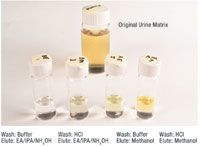Development of a High-throughput LC–MS–MS Assay for 13 Commonly Prescribed Pain Management Drugs from Urine with Clean-up Using Solid-phase Extraction (SPE)
The Application Notebook
In pain management analysis, urine is often used as it is a copiously available bodily fluid that can be collected easily and used for analysis.
Erica Pike, Carl Sanchez, Philip J. Koerner and Sky Countryman, Phenomenex Inc., Torrance, California, USA
Introduction
In pain management analysis, urine is often used as it is a copiously available bodily fluid that can be collected easily and used for analysis. Urine, however, can cause difficulties in analysis due to the variances in the endogenous nature of the urine matrix, which can impact the chromatographic separation and quantification.
The rapid analysis of 13 commonly prescribed pain management compounds from urine is achieved using a strong cation exchange SPE clean-up and concentration step followed by fast (<2 minutes) UHPLC analysis using a new core-shell column technology coupled to MS–MS.
Methods
Five different lots of urine samples were spiked at therapeutically relevant concentrations with 13 commonly prescribed drugs, including hydrocodone, nalterxone, tramadol and fentanyl. The lower limit of quantification (LLOQ) was targeted for 10× below the therapeutic prescription limit with less than 20% RSD at LLOQ. 10× above cutoff was set for the upper limit of quantification (ULOQ).
Urine samples were first hydrolysed to convert the glucuronide metabolites to native form using β-glucuronidase. Hydrolysed samples were then adjusted to a pH of 5.95 with 100 mM ammonium acetate buffer. Clean-up was done using a 30 mg/3 mL polymer-based high cation exchange capacity media to remove endogenous matrix components (Table 1). Analysis was done using an Agilent 1200SL HPLC coupled to an Applied Biosystems 4000 QTRAP (with Turbo V ion source) using a new core-shell HPLC column technology. Conditions for both are listed in their respective figures and tables.

Table 1: SPE protocol.
Results and Discussion
The analysis of all 13 pain management drugs was completed in less than 1.5 minutes with a total gradient cycle time from injection to injection of less than 2.2 minutes (Figure 1). The use of the new Kinetex core-shell HPLC column technology provided extremely sharp chromatographic bands with average peak width at base of 1–2 seconds. This extremely narrow peak width challenged the scan rate of the 4000 QTRAP MS requiring the use of scheduled MRM transition windows to ensure enough scans per peak for accurate quantification. The narrow peak width also translated to a significant increase in MS sensitivity, requiring the dilution of some samples by 20 times to bring concentrations within the dynamic range of the system.

Figure 1: LCâMSâMS analysis of pain panel drugs.
The analytical method resulted in a LLOQ of 2.5 ng/mL with accuracy of 83–98% for all compounds, with the exception of fentanyl, which had a LLOQ of 0.05 mg/mL due to its low therapeutic concentration. At LLOQ and 3× LLOQ, most RSDs were well below 15%, indicating a wide linear working range for all compounds. Method performance at cutoff was better than at the LLOQ or ULOQ, indicating that there may have been problems with dilutions during sample preparation; future work will be done to confirm this. The cutoff concentrations are defined as 300 ppb for all compounds except for fentanyl, ~50 times greater than morphine, the linear analytical range of fentanyl is reported at 50× lower concentration than the other pain panel opioids. At cutoff concentrations all compounds were analysed with 84–102% accuracy and 5% or less RSD values. Lot-to-lot precision and accuracy were also examined and produced RSD values that were all less than 7% with high accuracy regardless of the urine donor.
The Strata-X-C SPE protocol has been optimized for the 13 analytes and the internal standards. The chosen buffer, ammonium acetate, is adjusted to pH 5.95 to protonate and charge the cationic analytes at 2 pH units below their pKa values, which are all close to 8. Endogenous contaminants with lower pKa values will not be retained, which allows for the 100% methanol wash to more effectively remove contaminants such as uronilin that may appear yellow. The elution solution is 60:24:16 ethyl acetate:IPA:NH4OH, which is employed to solubilize or disrupt the retention of fewer endogenous contaminants during elution. Optimized wash and elution solutions yield clearer and cleaner eluents and more reproducible and accurate chromatography (Figure 2). The sorbent mass was also optimized to 30 mg of media in a 3 mL tube. The high ion-exchange capacity of the media allows for processing small sample volumes even at low concentrations.

Figure 2: Optimization of wash and elution conditions for SPE.
Conclusion
The combination of an extremely targeted and consistent sample preparation method and the highly efficient Kinetex column yielded a significant increase in productivity and throughput while solvent usage and analysis time were minimized. Due to the tremendously high recoveries of the method, only 1 mL of urine was required for clean-up on the Strata-X-C SPE sorbent. Using less sorbent reduces cost and solvent consumption and allows for small volume elution aliquots thereby saving time during evaporation for high sample throughput and increased productivity. The highly efficient Kinetex core-shell technology HPLC column allowed for an extremely fast analysis time without sacrificing separation and peak shape.
For complete details regarding this application, please contact Phenomenex and request Technical Note TN-1070.
Kinetex and Strata-X are trademarks of Phenomenex Inc.

Phenomenex Inc.
411 Madrid Avenue, Torrance, California 90501, USA
tel. +1 310 212 0555 fax +1 310 328 7768
E-mail: info@phenomenex.com
Website: www.phenomenex.com















